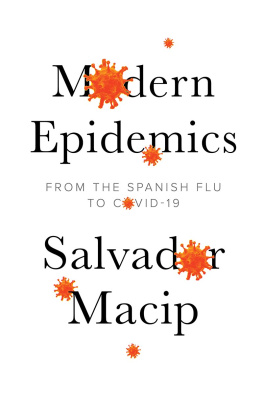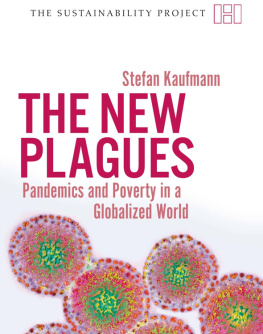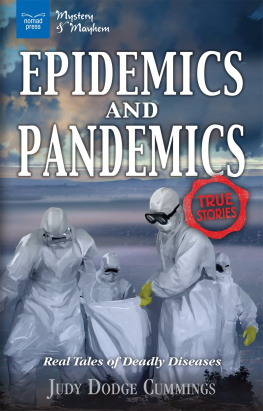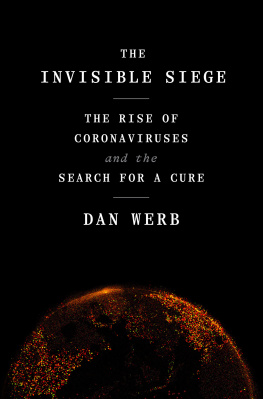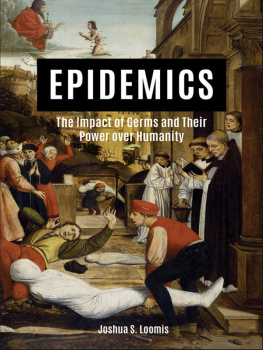CONTENTS
Guide
Pages
MODERN EPIDEMICS
From the Spanish Flu to COVID-19
Salvador Macip
Translated from Catalan by Julie Wark
polity
Salvador Macip Maresma, 2020
Revised, updated and expanded text by Salvador Macip from his work Les grans epidmies modernes originally published in Catalan by La Campana. Translation rights arranged by Asterisc Agents. All rights reserved.
This English edition 2021 by Polity Press

This book has been supported by the Institut Ramon Llull
Polity Press
65 Bridge Street
Cambridge CB2 1UR, UK
Polity Press
101 Station Landing
Suite 300
Medford, MA 02155, USA
All rights reserved. Except for the quotation of short passages for the purpose of criticism and review, no part of this publication may be reproduced, stored in a retrieval system or transmitted, in any form or by any means, electronic, mechanical, photocopying, recording or otherwise, without the prior permission of the publisher.
ISBN-13: 978-1-5095-4658-9
A catalogue record for this book is available from the British Library.
The publisher has used its best endeavours to ensure that the URLs for external websites referred to in this book are correct and active at the time of going to press. However, the publisher has no responsibility for the websites and can make no guarantee that a site will remain live or that the content is or will remain appropriate.
Every effort has been made to trace all copyright holders, but if any have been overlooked the publisher will be pleased to include any necessary credits in any subsequent reprint or edition.
For further information on Polity, visit our website: politybooks.com
Dedication
For my mother:
Thank you for all these years of unconditional support
The smallest unit of life a single bacterial cell is a monument of pattern and process unrivalled in the universe as we know it.
Lynn Margulis and Dorion Sagan, Microcosmos:
Four Billion Years of Microbial Evolution (University of California Press, 1986)
But there is something terrifying about the fact that nothing can stop the implacable evolution of these viruses as they test, through mindless mutation, ever more strategies to facilitate their survival, a survival that just may represent disease and death for us humans.
C. J. Peters and Mark Olshaker, Virus Hunter:
Thirty Years of Battling Hot Viruses around the World (Anchor Books, 1997)
Acknowledgements
My thanks to colleagues who guided my first steps in the fascinating world of studying microorganisms: Dr Luca Gusella, Dr Arantxa Horga, Dr Adolfo Garca-Sastre and Dr Luis Martnez-Sobrido. And more thanks for the deliberations and conversations that have ended up appearing in this book. A thousand thanks to Dr Jordi Gmez i Prat, Dr Marta Giralt, Dr Joan Fontdevila and Dr Ana Fernndez Sesma for their help, their selfless supervision, and for letting me interview them. Another thousand to C. J. Peters, L. Margulis, D. Sagan, D. H. Crawford, D. Grady, G. Kolata and M. Siegel for their books on the subject, which have been my references.
My gratitude to Gonzalo Pontn for his contribution in giving shape to this project, to Pau Centellas and Carlota Torrents for their part in bringing into being what finally ended up as a book, to Emili Rosales and Ramn Perell for enabling the project grow, to Isabel Mart and Josep Maria Espins for their guidance in polishing it, and to John Thompson and Elise Heslinga for helping me turn it into a much better book.
As always, my thanks to Yolanda, Pol, Antoni-Jordi, Josefina and Ana for being at my side, for helping me in difficult moments, and for being unsparing with their criticism.
Introduction
An ever-present danger
In spring 2009, there was an outbreak in Mexico of an influenza pandemic that spread unstoppably around the world in just a few weeks. Many people were taken by surprise as they hadnt imagined that, with all the advances in medicine today, we could still feel so helpless when faced with such a common virus. Yet, scientists had been predicting it for quite some time. When the first edition of this book was published, over a decade ago, by which time that pandemic had started to abate, I was interviewed by some newspapers and repeated the same thing several times: it was indisputable that there would be another pandemic in a few years time, and we had better prepare in case the virus that would be circulating then turned out to be more aggressive than A(H1N1), the so-called swine flu virus, which was creating so many problems. Such long-term prophecies are easy to make because, if you are wrong, no one remembers, so you dont get taken to task about it afterwards. But, in this case, it wasnt prediction but certainty. All the experts I had spoken to or read while writing this book agreed that it was inevitable. Everyone who had sufficiently studied the matter came to the same conclusion: it wasnt a matter of waiting to see if it would happen but when it would happen.
When I said this, people looked at me not so much with fear as with an amused or incredulous expression. Another alarmist, they must have thought. In the Epilogue of this book, I explain how the publishers of the first version were also surprised when I anticipated the 2009 pandemic some months before it happened. They had an excuse, because they hadnt experienced an infectious disease of such dimensions, but the attitude should have changed after the A(H1N1) flu, which could be regarded as the first pandemic of the modern era, the first to have attacked a globalized, frontierless world. This should have warned us of what can happen when, faced with the appearance of an unknown virus against which we have no defences, we are obliged to act swiftly in order to avert a possible tragedy. But, even so, the outbreak of COVID-19, the disease caused by the new virus called SARS-CoV-2, caught us unawares.
The responses to this second great twenty-first century world health crisis (in terms of viruses) are very similar to those of the first one, namely confusion, panic and uncertainty. Once again, mismanaged information has sown distrust among the public. Perhaps there is one slight improvement in that many countries have responded faster and have shared important data more efficiently. Despite the doubts and unnecessary delays of the early weeks, protective measures are now being more firmly applied. Yet, there are many issues still to be resolved if we want to be better prepared for future pandemics.
Fortunately, SARS-CoV-2 isnt the supervirus that I talk about later in these pages, but it does raise more logistical problems than any of the flu viruses weve seen recently. Although we are still not well enough informed about it, we do know that it spreads very fast (partly because those affected are contagious for a long period without symptoms), and that it has a relatively low mortality rate of probably somewhere near 1 per cent. To give some perspective, this is ten times higher than the 0.1 per cent for seasonal flu but much lower than the 5080 per cent for Ebola. If we add up these factors, as well as the many uncertainties, there are more than enough reasons to be cautious and to act as fast as possible. Its true that the symptoms it presents are relatively mild in most cases, but in some, especially for certain groups of the population (for example, elderly people and those with serious illnesses), it can be fatal. This, together with the great ease of contagion, can create very serious problems of global health, which is why it is essential to prevent its spread as soon as possible.

